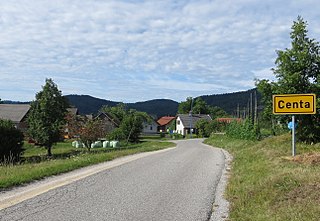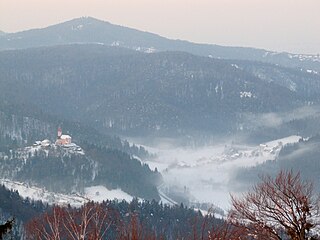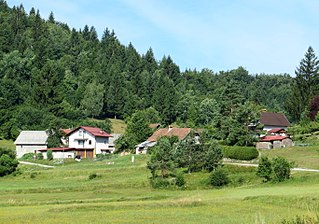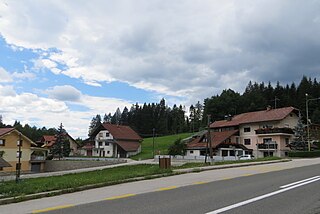| Mala Slevica | |
|---|---|
 | |
| Coordinates: 45°48′32.08″N14°37′39.01″E / 45.8089111°N 14.6275028°E Coordinates: 45°48′32.08″N14°37′39.01″E / 45.8089111°N 14.6275028°E | |
| Country | |
| Traditional region | Lower Carniola |
| Statistical region | Central Slovenia |
| Municipality | Velike Lašče |
| Area | |
| • Total | 1.26 km2 (0.49 sq mi) |
| Elevation | 596.3 m (1,956.4 ft) |
| Population (2002) | |
| • Total | 160 |
| [1] | |
Mala Slevica (pronounced [ˈmaːla ˈsleːʋitsa] ; in older sources also Mala Slivica, [2] German : Kleinsliwitz [2] ) is a settlement south of Velike Lašče in central Slovenia. The entire Municipality of Velike Lašče is part of the traditional region of Lower Carniola and is now included in the Central Slovenia Statistical Region. [3]

German is a West Germanic language that is mainly spoken in Central Europe. It is the most widely spoken and official or co-official language in Germany, Austria, Switzerland, South Tyrol (Italy), the German-speaking Community of Belgium, and Liechtenstein. It is also one of the three official languages of Luxembourg and a co-official language in the Opole Voivodeship in Poland. The languages which are most similar to German are the other members of the West Germanic language branch: Afrikaans, Dutch, English, the Frisian languages, Low German/Low Saxon, Luxembourgish, and Yiddish. There are also strong similarities in vocabulary with Danish, Norwegian and Swedish, although those belong to the North Germanic group. German is the second most widely spoken Germanic language, after English.

Velike Lašče is a town in Slovenia. It is the seat of the Municipality of Velike Lašče. It is part of the traditional region of Lower Carniola and is now included in the Central Slovenia Statistical Region.

Slovenia, officially the Republic of Slovenia, is a sovereign state located in southern Central Europe at a crossroads of important European cultural and trade routes. It is bordered by Italy to the west, Austria to the north, Hungary to the northeast, Croatia to the southeast, and the Adriatic Sea to the southwest. It covers 20,273 square kilometers (7,827 sq mi) and has a population of 2.07 million. One of the successor states of the former Yugoslavia, Slovenia is a parliamentary republic and a member of the United Nations, of the European Union, and of NATO. The capital and largest city is Ljubljana.



















